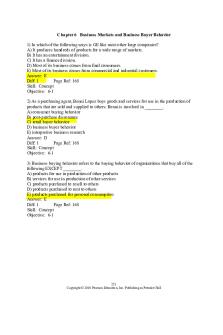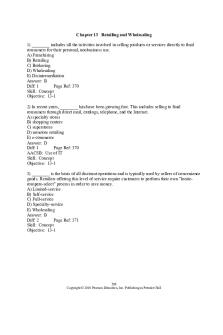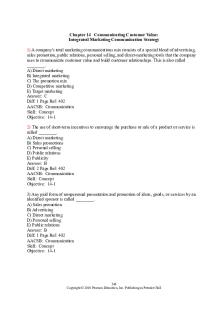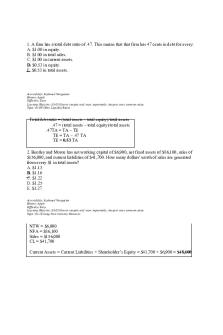Kotler Chapter 3 MCQ - Multiple choice questions with answers PDF

| Title | Kotler Chapter 3 MCQ - Multiple choice questions with answers |
|---|---|
| Course | Principles of Marketing |
| Institution | The University of the West Indies Mona |
| Pages | 45 |
| File Size | 288.4 KB |
| File Type | |
| Total Downloads | 321 |
| Total Views | 498 |
Summary
Chapter 3 Analyzing the Marketing Environment You are directed to study the actors close to the company that affect its ability to serve its customers-departments within the company, suppliers, marketing intermediaries, customer markets, competitors, and publics. What are you studying? A) the macroe...
Description
Chapter 3 Analyzing the Marketing Environment 1) You are directed to study the actors close to the company that affect its ability to serve its customers-departments within the company, suppliers, marketing intermediaries, customer markets, competitors, and publics. What are you studying? A) the macroenvironment B) the microenvironment C) the marketing environment D) the demographic environment E) the global environment Answer: B Diff: 1 Page Ref: 66 Skill: Concept Objective: 3-1 2) Which of the following terms is used to describe the factors and forces outside marketing that affect marketing management's ability to build and maintain successful relationships with target customers? A) the marketing environment B) the cultural environment C) strategic planning D) target markets E) the marketing mix Answer: A Diff: 1 Page Ref: 66 Skill: Concept Objective: 3-1 3) You are directed to study the demographic, economic, natural, technological, political, and cultural factors that are larger societal forces affecting your company. What are you studying? A) the macroenvironment B) the microenvironment C) the external environment D) the marketing mix E) the global environment Answer: A Diff: 1 Page Ref: 66 Skill: Concept Objective: 3-1
88 Copyright © 2010 Pearson Education, Inc. Publishing as Prentice Hall
4) Which of the following is NOT a type of factor in a company's macroenvironment? A) demographic B) economic C) technological D) competitive E) political Answer: D Diff: 1 Page Ref: 66 Skill: Concept Objective: 3-1 5) All of the groups within a company are called the ________. A) culture B) diversity C) internal environment D) climate E) range Answer: C Diff: 2 Page Ref: 67 Skill: Concept Objective: 3-1 6) Which type of organization helps companies to stock and move goods from their points of origin to their destination? A) financial intermediaries B) physical distribution firms C) marketing services agencies D) resellers E) suppliers Answer: B Diff: 1 Page Ref: 68 Skill: Concept Objective: 3-1 7) Banks, credit companies, insurance companies, and other businesses that help finance transactions or insure against the risks associated with the buying and selling of goods and services are referred to as ________. A) financial intermediaries B) physical distribution firms C) marketing services agencies D) resellers E) wholesalers Answer: A Diff: 1 Page Ref: 68 Skill: Concept Objective: 3-1
89 Copyright © 2010 Pearson Education, Inc. Publishing as Prentice Hall
8) Currently, Diego Calabresa is employed by a firm that conducts marketing research and creates ads for other companies that help them target and promote their products to the right markets. Who is Diego's employer? A) a financial intermediary B) a physical distribution firm C) a marketing service agency D) a reseller E) a green marketer Answer: C Diff: 2 Page Ref: 68 Skill: Concept Objective: 3-1 9) A ________ is defined as any group that has an actual or potential interest in, or impact on, an organization's ability to achieve its objectives. A) team B) competitor C) market D) public E) intermediary Answer: D Diff: 1 Page Ref: 69 AACSB: Communication Skill: Concept Objective: 3-1 10) Which of the following is NOT an example of the type of public that is part of a company's marketing environment? A) financial B) media C) government D) citizen-action E) marketing department Answer: E Diff: 1 Page Ref: 69 AACSB: Communication Skill: Concept Objective: 3-1
90 Copyright © 2010 Pearson Education, Inc. Publishing as Prentice Hall
11) A radio station that carries news, features, and editorial opinions about your area is which type of public? A) financial B) media C) citizen-action D) local E) government Answer: B Diff: 1 Page Ref: 69 AACSB: Communication Skill: Concept Objective: 3-1 12) A consumer organization, environmental group, or minority group has challenged your firm's stand on a local issue. Your firm is being challenged by a ________ public. A) local B) general C) government D) citizen-action E) media Answer: D Diff: 1 Page Ref: 69 AACSB: Reflective Thinking Skill: Concept Objective: 3-1 13) Workers, managers, and members of the board are all part of a company's ________ public. A) general B) internal C) local D) intermediary E) market Answer: B Diff: 1 Page Ref: 69 Skill: Concept Objective: 3-1
91 Copyright © 2010 Pearson Education, Inc. Publishing as Prentice Hall
14) Percy Original caters to a market of individuals and households that buys goods and services for personal consumption. Percy Original caters to a ________ market. A) business B) reseller C) government D) consumer E) marketing intermediary Answer: D Diff: 2 Page Ref: 69 Skill: Concept Objective: 3-1 15) Which type of market buys goods and services for further processing or for use in the production process? A) business B) reseller C) wholesale D) consumer E) retail Answer: A Diff: 2 Page Ref: 69 Skill: Concept Objective: 3-1 16) Which type of market buys goods and services to produce public services or to transfer them to others who need them? A) government B) reseller C) wholesale D) consumer E) retail Answer: A Diff: 1 Page Ref: 69 Skill: Concept Objective: 3-1
92 Copyright © 2010 Pearson Education, Inc. Publishing as Prentice Hall
17) Rachel Patino works for a wholesale company called Distributors Unlimited. She is responsible for buying and selling goods at a profit to small retailers. What is her market? A) business B) reseller C) wholesale D) consumer E) retail Answer: B Diff: 1 Page Ref: 69 Skill: Concept Objective: 3-1 18) Your marketing department is currently researching the size, density, location, age, and occupations of your target market. Which environment is being researched? A) demographic B) psychographic C) economic D) geographic E) cultural Answer: A Diff: 1 Page Ref: 70 Skill: Concept Objective: 3-2 19) The three largest generational groups in America are the baby boomers, Generation Xers, and ________. A) seniors B) Millennials C) teens D) tweens E) toddlers Answer: B Diff: 1 Page Ref: 71 AACSB: Multicultural and Diversity Skill: Concept Objective: 3-2
93 Copyright © 2010 Pearson Education, Inc. Publishing as Prentice Hall
20) As a group, ________ are the most affluent Americans. A) baby boomers B) Generation Xers C) the Millennials D) echo boomers E) seniors Answer: A Diff: 2 Page Ref: 71 AACSB: Multicultural and Diversity Skill: Concept Objective: 3-2 21) Research has shown that the most important demographic trend in the United States is the ________. A) changing age structure of the population B) mobility of families C) slowing birth rate D) increasing number of professional jobs E) aging population Answer: A Diff: 3 Page Ref: 71 AACSB: Multicultural and Diversity Skill: Concept Objective: 3-2 22) The youngest of the baby boomers are now in their ________. A) late 20s B) mid-20s C) mid-40s D) early 50s E) early 60s Answer: C Diff: 2 Page Ref: 71 AACSB: Multicultural and Diversity Skill: Concept Objective: 3-2
94 Copyright © 2010 Pearson Education, Inc. Publishing as Prentice Hall
23) Which of the following descriptions most accurately characterizes the baby boomers? A) They are increasingly likely to retire early. B) They are a shrinking market for new housing and home remodeling. C) They are past their peak earning and spending years. D) They hold 75% of the country's assets. E) They are uninterested in adapting new technologies. Answer: D Diff: 2 Page Ref: 71 AACSB: Multicultural and Diversity Skill: Concept Objective: 3-2 24) Which of the following descriptions most accurately characterizes Gen Xers? A) There are more Gen Xers than Millennials. B) They were the first generation of latchkey kids. C) They grew up during times of great economic growth. D) They are more interested in acquiring goods than having experiences. E) They rarely research a product before purchasing it. Answer: B Diff: 2 Page Ref: 72 AACSB: Multicultural and Diversity Skill: Concept Objective: 3-2 25) Which demographic group is also referred to as the echo boomers? A) Generation X B) Millennials C) Generation Z D) baby boomers E) baby busters Answer: B Diff: 2 Page Ref: 74 AACSB: Multicultural and Diversity Skill: Concept Objective: 3-2
95 Copyright © 2010 Pearson Education, Inc. Publishing as Prentice Hall
26) Large tween and teen markets belong to which demographic group? A) Generation X B) Millennials C) baby busters D) baby boomers E) Generation Z Answer: B Diff: 1 Page Ref: 74 AACSB: Multicultural and Diversity Skill: Concept Objective: 3-2 27) Which of the following descriptions most accurately characterizes Millennials? A) They are children of baby boomers. B) They are less ethnically diverse than Gen Xers. C) They have reached their peak earning and spending years. D) They were once labeled "the MTV generation." E) They have graduated from college and are taking over positions of power in the business world. Answer: A Diff: 2 Page Ref: 74 AACSB: Multicultural and Diversity Skill: Concept Objective: 3-2 28) Which demographic group is characterized by a total fluency and comfort with computer, digital, and Internet technology? A) Generation X B) Millenials C) the elderly D) Generation Z E) baby boomers Answer: B Diff: 1 Page Ref: 74 AACSB: Multicultural and Diversity Skill: Concept Objective: 3-2
96 Copyright © 2010 Pearson Education, Inc. Publishing as Prentice Hall
29) Which of the following demographic groups has NOT seen a percentage increase in the past 50 years? A) women staying at home with their children B) men staying at home with their children C) nontraditional households D) nonfamily households E) women working outside of the home Answer: A Diff: 3 Page Ref: 75-76 AACSB: Multicultural and Diversity Skill: Concept Objective: 3-2 30) Ameriprise Financial has published a Dream Book guide, one of the first steps in their Dream > Plan > Track approach to financial planning, as part of their strategy to attract ________ as customers. A) baby boomers B) Gen Xers C) echo boomers D) Millennials E) professionals Answer: A Diff: 2 Page Ref: 73 Skill: Concept Objective: 3-2 31) "Dreams don't retire" is the theme of a(n) ________ marketing campaign aimed at baby boomers. A) financial services B) anti-aging products C) travel and entertainment D) fitness products E) technological products Answer: A Diff: 2 Page Ref: 73 Skill: Concept Objective: 3-2
97 Copyright © 2010 Pearson Education, Inc. Publishing as Prentice Hall
32) In 1950, women made up under 40 percent of the workforce; now they make up ________ percent. A) 35 B) 40 C) 43 D) 46 E) 59 Answer: E Diff: 3 Page Ref: 75 AACSB: Multicultural and Diversity Skill: Concept Objective: 3-2 33) Which of the following is a trend that depicts the increasingly nontraditional nature of today's American family? A) working women making up a smaller percentage of the workforce B) the falling percentage of married couples with children C) dual-income families declining in number D) stay-at-home dads declining in number E) the declining reliance on convenience foods and services Answer: B Diff: 2 Page Ref: 75 AACSB: Multicultural and Diversity Skill: Concept Objective: 3-2 34) Over the past two decades, the U.S. population has shifted most heavily toward the ________ states. A) Midwestern B) Northern C) Sunbelt D) Southeastern E) Northeastern Answer: C Diff: 2 Page Ref: 76 Skill: Concept Objective: 3-2
98 Copyright © 2010 Pearson Education, Inc. Publishing as Prentice Hall
35) Which of the following geographical areas has NOT seen a recent population increase? A) micropolitan areas B) suburbs C) the West D) the Northeast E) the South Answer: D Diff: 3 Page Ref: 76 Skill: Concept Objective: 3-2 36) In the 1950s, the American population began shifting from large cities to ________. A) farming communities B) rural areas C) foreign countries D) suburbs E) coastal towns Answer: D Diff: 1 Page Ref: 76 Skill: Concept Objective: 3-2 37) Which of the following is the most reasonable to assume as more and more Americans move to "micropolitan areas"? A) Geographic segmentation may be less critical to marketers. B) Rural populations will offer an expanding market. C) Micropolitan areas are likely to offer the same advantages as metropolitan areas. D) Congested areas are likely to become more ensnarled. E) Crime rates in metropolitan areas will increase. Answer: C Diff: 3 Page Ref: 76 AACSB: Analytic Skills Skill: Concept Objective: 3-2
99 Copyright © 2010 Pearson Education, Inc. Publishing as Prentice Hall
38) Nearly 10 percent of American workers currently work out of their homes with technological conveniences such as PCs, Internet access, and fax machines. These workers are referred to as the ________ market. A) micropolitan B) SOHO C) mobile D) independent E) contract Answer: B Diff: 2 Page Ref: 76 AACSB: Use of IT Skill: Concept Objective: 3-2 39) Which of the following groups of workers is projected to become smaller over the next ten years? A) white collar workers B) manufacturing workers C) managers D) telecommuters E) professional workers Answer: B Diff: 3 Page Ref: 77 AACSB: Multicultural and Diversity Skill: Concept Objective: 3-2 40) Because of increasing ________, Americans will demand higher quality products, books, magazines, travel, personal computers, and Internet services. A) numbers of nontraditional families B) family size C) levels of education D) social class awareness E) ethnic diversity Answer: C Diff: 2 Page Ref: 77 AACSB: Multicultural and Diversity Skill: Concept Objective: 3-2
100 Copyright © 2010 Pearson Education, Inc. Publishing as Prentice Hall
41) Which of the following is an accurate statement about the diversity of the American population? A) African Americans represent the largest non-white segment of the population. B) More than 12 percent of people living in the United States were born in another country. C) The Asian American percentage of the population is expected to remain steady in the next 50 years. D) In terms of ethnic diversity, the United States is about average in comparison to other countries with populations of a comparable size. E) American ethnic populations are expected to slowly increase in the next few decades. Answer: B Diff: 3 Page Ref: 77 AACSB: Multicultural and Diversity Skill: Concept Objective: 3-2 42) Of the following, which is the fastest-growing ethnic minority in the United States? A) African Americans B) Asian Americans C) Hispanics D) Native Americans E) Arab Americans Answer: C Diff: 2 Page Ref: 77 AACSB: Multicultural and Diversity Skill: Concept Objective: 3-2 43) With an expected increase in ethnic populations, marketers are likely to place a greater emphasis on ________. A) geographic segmentation B) targeted advertising messages C) mass marketing D) mainstream advertising E) cause-related marketing Answer: B Diff: 2 Page Ref: 77 AACSB: Multicultural and Diversity Skill: Concept Objective: 3-2
101 Copyright © 2010 Pearson Education, Inc. Publishing as Prentice Hall
44) Members of which of the following groups are more likely than the average American to have a professional job, have a household income over $250,000, own a vacation home, own a notebook computer, and own individual stocks? A) Gen Xers B) gays and lesbians C) Millennials D) echo boomers E) environmentalists Answer: B Diff: 3 Page Ref: 78 AACSB: Multicultural and Diversity Skill: Concept Objective: 3-2 45) Of the following diversity segments in the American population, which is currently the largest? A) adults with disabilities B) Hispanics C) African Americans D) telecommuters E) Asian Americans Answer: A Diff: 2 Page Ref: 78 AACSB: Multicultural and Diversity Skill: Concept Objective: 3-2 46) The ________ environment consists of factors that affect consumer purchasing power and spending patterns. A) cultural B) political C) technological D) economic E) natural Answer: D Diff: 1 Page Ref: 79 Skill: Concept Objective: 3-2
102 Copyright © 2010 Pearson Education, Inc. Publishing as Prentice Hall
47) A country with a(n) ________ economy consumes most of its own agricultural and industrial outputs and offers few market opportunities. A) industrial B) service C) technological D) subsistence E) rural Answer: D Diff: 2 Page Ref: 79 AACSB: Multicultural and Diversity Skill: Concept Objective: 3-2 48) A country with a(n) ________ economy has rich markets for many different kinds of goods. A) industrial B) service C) developing D) subsistence E) multicultural Answer: A Diff: 2 Page Ref: 79 AACSB: Multicultural and Diversity Skill: Concept Objective: 3-2 49) Which of the following factors has NOT contributed to today's age of the "tapped-out consumer"? A) rising incomes in the upper class B) debt repayment C) increasing household expenses D) savings for college tuition E) savings for retirement Answer: A Diff: 2 Page Ref: 80 AACSB: Analytic Skills Skill: Concept Objective: 3-2
103 Copyright © 2010 Pearson Education, Inc. Publishing as Prentice Hall
50) Value marketing is the strategy of offering consumers ________. A) high quality at a high price B) luxury quality at a high price C) lesser quality at a low price D) reasonable quality at a fair price E) little quality at a low price Answer: D Diff: 2 Page Ref: 80 Skill: Concept Objective: 3-2 51) Which of the following statements about income distribution in the United States is NOT true? A) In recent decades, the rich have gotten richer. B) In recent decades, the middle class has grown. C) In recent decades, the poor have remained poor. D) The top 10 percent of American earners account for almost half of all American income. E) The top one percent of American earners receive a higher percentage of the nation's total income than do the bottom 50 percent of American earners. Answer: B Diff: 3 Page Ref: 80 AACSB: Multicultural and Diversity Skill: Concept Objective: 3-2 52) In a tiered market, companies target which of the following? A) affluent consumers only B) consumers of modest means only C) the middle class only D) consumers at all levels of income distribution E) professionals only Answer: D Diff: 2 Page Ref: 80 Skill: Concept Objective: 3-2 53) Which of the following groups of expenses uses up the most household income? A) food, housing, retirement planning B) housing, insurance, taxes C) food, housing, transportation D) housing, taxes, transportation E) food, travel, savings Answer: C Diff: 2 Page Ref: 81 Skill: Concept Objective: 3-2
104 Copyright © 2010 Pearson Education, Inc. Publishing as Prentice Hall
54) Ernst Engel's laws generally have been supported by recent studies. He discovered that as family income rises, the percentage spent on ________ declines and the percentage spent on ________ remains about constant. A) food; clothing B) clothing; recreation/entertainment C) food; transportation D) food; housing E) recreation/entertainment; savings Answer: D Diff: 2 Page Ref: 81 Skill: Concept Objective: 3-2 55) The natural resources that are needed as inputs by marketers or that are affected by marketing activities are referred to as the ________. A) raw material market B) natural environment C) endangered environment D) green movement E) factors of production Answer: B Diff: 1 Page Ref: 81 Skill: Concept Objective: 3-3 56) Which of the following American government agencies is charged with setting and enforcing pollution standards? A) the Environmental Protection Agency (EPA) B) the Federal Trade Commission (FTC) C) the Food and Drug Administration (FDA) D) the Consumer Product Safety Commission E) the Federal Energy Regulatory Commission Answer: A Diff: 2 Page Ref: 81 AACSB: Ethical Reasoning Skill: Concept Objective: 3-3
105 Copyright © 2010 Pearson Education, Inc. Publishing as Prentice Hall
57) Which of the following has encouraged marketers to pursue environmentally sustainable strategies? A) the EPA B) the black market C) the green movement D) deregulation E) green intervention Answer: C Diff: 2 Page Ref: 82 AACSB: Ethical Reasoning Skill: Concept Objective: 3-3 58) Which o...
Similar Free PDFs
Popular Institutions
- Tinajero National High School - Annex
- Politeknik Caltex Riau
- Yokohama City University
- SGT University
- University of Al-Qadisiyah
- Divine Word College of Vigan
- Techniek College Rotterdam
- Universidade de Santiago
- Universiti Teknologi MARA Cawangan Johor Kampus Pasir Gudang
- Poltekkes Kemenkes Yogyakarta
- Baguio City National High School
- Colegio san marcos
- preparatoria uno
- Centro de Bachillerato Tecnológico Industrial y de Servicios No. 107
- Dalian Maritime University
- Quang Trung Secondary School
- Colegio Tecnológico en Informática
- Corporación Regional de Educación Superior
- Grupo CEDVA
- Dar Al Uloom University
- Centro de Estudios Preuniversitarios de la Universidad Nacional de Ingeniería
- 上智大学
- Aakash International School, Nuna Majara
- San Felipe Neri Catholic School
- Kang Chiao International School - New Taipei City
- Misamis Occidental National High School
- Institución Educativa Escuela Normal Juan Ladrilleros
- Kolehiyo ng Pantukan
- Batanes State College
- Instituto Continental
- Sekolah Menengah Kejuruan Kesehatan Kaltara (Tarakan)
- Colegio de La Inmaculada Concepcion - Cebu















